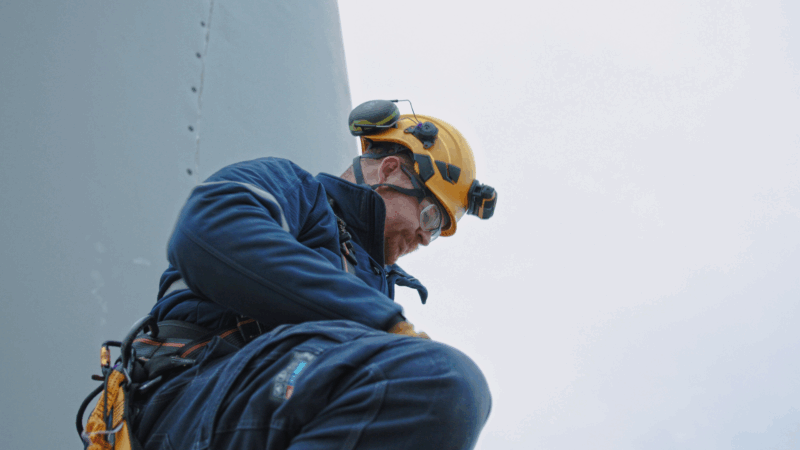Breaking into the wind energy sector? Whether you’re just starting your career or making a shift from another industry, knowing what skills and knowledge to bring can help you stand out—especially in the competitive role of a wind turbine service technician.
From electrical know-how to the right mindset, here’s what employers in the wind industry are really looking for.
This article is based on a webinar hosted in May 2025, led by Craig Robertson, our lead technical trainer. It’s intended as a helpful guide not a guaranteed formula for landing your dream job but we hope it gives you a solid starting point.
Electrical Knowledge Comes First
Wind turbines are becoming increasingly complex—especially when it comes to their electrical systems. Out of the three core disciplines (electrical, mechanical, and hydraulic), electrical knowledge is the most essential for service technicians.
- Faults in electrical systems are harder to detect than mechanical or hydraulic ones.
- Electrical complexity is only increasing as turbine technology advances.
- Understanding how real-world systems work is a major advantage.
💡 Tip: Build electrical skills through hands-on hobbies—like wiring lights, building drones, or setting up off-grid systems.
Mechanical & Hydraulic Understanding
While electrical knowledge is critical, mechanical and hydraulic systems are still core components of wind turbines.
- Mechanical issues are often more obvious (e.g., broken parts, visible wear).
- Hydraulic failures typically leave evidence (like fluid leaks or actuator malfunctions).
💡 Tip: Backgrounds in automotive, construction, or general trades are great foundations for learning these systems.
Safety Awareness & Mindset
In wind energy, safety isn’t optional—it’s the foundation of every task you’ll do. Associations like SafetyOn help safeguard the standards of the industry.
- If you’ve stopped work in a previous job due to a safety concern, highlight that.
- Familiarity with health and safety procedures, incident reporting, and regulations is highly valued.
- Understanding or having exposure to Wind Turbine Safety Rules is a major plus.
💡 Tip: Think of examples where you made safety a priority and be ready to share them in interviews.
Attitude Matters More Than Experience
Your attitude can outweigh qualifications. Some of the best wind turbine technicians in the field started as chefs, builders, or general laborers.
- The key trait? A willingness to learn and understand how systems work.
- You must take ownership of your development—study manuals, review training materials, and ask questions.
💡 Tip: Show you’re proactive. Employers notice when candidates go the extra mile to learn.
Choosing the Right Training
If you’re planning on studying before applying, choose wisely.
- HNC/HND in Electrical Engineering is a strong foundation.
- Mechatronics is especially useful—it blends electrical, mechanical, and automation, closely mirroring turbine systems.
- Be cautious with general “renewable energy” degrees—some focus more on analytics than hands-on work.
💡 Tip: Before enrolling, check course modules to ensure they include practical, hands-on technical training.
GWO & BTT Training
Most wind turbine jobs require GWO (Global Wind Organisation) certifications:
- Working at Height
- Manual Handling
- Fire Awareness
- Sea Survival (offshore only)
- Advanced Rescue
Additionally, BTT (Basic Technical Training) is useful, especially for non-technical candidates:
- Covers torque tools, multimeters, fault finding, and hydraulic basics.
💡 Tip: If you’re not ready for college, BTT is a great way to build foundational skills and boost your application.
OEM vs. ISP: Where Should You Apply?
There are two main types of companies in the wind industry:
OEM (Original Equipment Manufacturer)
- Build and maintain their own turbines.
- Larger teams, more structured training.
- You’ll likely work on newer equipment—but only on their specific turbine models.
ISP (Independent Service Provider)
- Only maintain turbines (no manufacturing).
- Often work on older or multiple turbine types.
- May provide broader hands-on experience across different systems.
💡 Tip: ISPs may be more open to hiring candidates with less experience—but apply to both.
Onshore vs. Offshore Wind Roles
Understanding the work environment is key when choosing your path.
Onshore:
- Often 9–5 with weekend call rotations.
- Typically easier for new starters.
- Travel from home to wind farm and back daily.
Offshore:
- Rotational shifts (e.g., 2 weeks on/2 weeks off).
- Long 12-hour days, 7 days a week while offshore.
- Higher risk and pressure—usually requires prior experience.
💡 Tip: Start onshore, gain experience, and transition offshore if that’s your goal.
Apprenticeships: Learn While You Earn
Apprenticeships are an excellent way to enter the wind industry, especially for younger candidates.
- Combine classroom learning (1 day/week) with real-world job experience.
- Usually offered by large companies (mostly OEMs).
- Expect lower pay initially, with growth over time.
💡 Tip: Check OEM career pages frequently—competition is high, and opportunities fill up fast.
Final Thoughts: Stand Out with What You Do Know
You don’t need a degree to break into wind energy—but you do need to show:
- 💡 Transferable skills (from trades, hobbies, or past jobs)
- 💪 A strong attitude and desire to learn
- 📘 Any relevant training (BTT, electrical courses, GWO certs)
Experience is valuable, but if you don’t have it yet, prove you’re willing to earn it. Your effort, mindset, and practical knowledge can get you noticed—and hired.
Was this helpful? Be sure to check out two other articles on this topic:
Top Qualities Every Wind Turbine Service Technician Needs to Succeed
Top Skills Every Wind Turbine Service Technician Should Build
